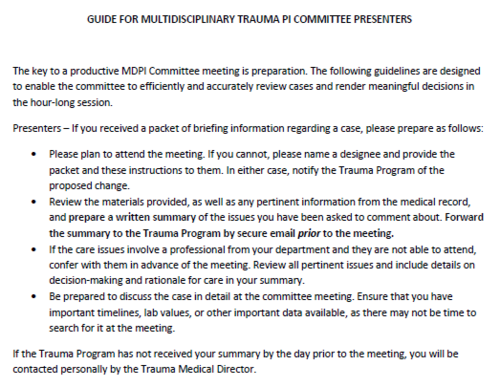This post is a little longer than usual. However, if you have any interest in trauma PI, I recommend you read it through to the very end.
I’ve written a lot about trauma performance improvement (PI) over the years. As many of you know, good PI is complicated yet necessary to run a trauma center that provides optimal care. There are many areas of trauma care that are scrutinized by the PI program on a daily basis. Some of those items are termed “audit filters”, and consist of specific action criteria. If not met, the filter is triggered and the PI program must investigate it.
One of those time-honored filters is “delay to operating room.” Actually, there are two parts to it. One is “trauma laparotomy > 4 hours after patient arrival.” And the other is “trauma laparotomy > 1 hour after patient arrival if hypotensive.”
A paper was recently published questioning the value of the first filter. The contention is that it takes time and money for someone (trauma registrar, nurses, or APPs) to recognize and record the violation, and more time for the trauma program manager, trauma medical director, and Trauma PI Committee to analyze and discuss.
The authors were concerned that this time and money may be mis-spent if the filter violation doesn’t have any real impact on clinical care and outcomes. They looked at 9 years of registry and PI data on initial trauma laparotomies (not reoperations) at their Level I center. They specifically compared the incidence of mortality, complications, and identification of opportunities for improvement in the PI program.
Here are the factoids:
- 472 patients underwent primary trauma laparotomy during the study, and 23% were flagged as delay to OR (!)
- There was no difference in mortality or complications between delayed and non-delayed patients
- There was a trend toward longer hospital length of stay in the delay group (p=0.05)
- Transfer to a higher level of care was significantly higher (7%) in the delayed patients vs non-delayed (2%). The authors do not explain this further, although it usually means an unanticipated transfer from ward to ICU.
- Other audit filters were triggered significantly more often in the delay group, including failed nonoperative management of spleen or liver, delay in diagnosis, and delay in presentation
- There were significant differences in which surgeons experienced delay to OR, although the incidence of complications was not different
Bottom line: The authors interpret this information one way, and state their belief that these types of filters may no longer be relevant at well-established trauma centers. However, I disagree!
Here is my rationale:
- The study assumes that deaths, complications, and the presence of identified opportunities for improvement are sensitive enough outcomes. They are not. Hospital length of stay is the only measure that the authors examined that might be related, and it was very close to being significantly higher. And in this day and age of team care, it’s very difficult to say exactly who or what did or did not produce a complication.
- It also assumes that the adverse outcome would only occur to the involved patient. What if an OR scheduling problem occurred in the audited case, but the patient’s injuries were not severe enough that there was any impact? But the next patient was more severely injured, and the same type of OR scheduling delay occurred. And in this case, significant and severe complications occurred even though they made it into the room in 3 hours and 45 minutes. System problems can hurt other patients, too!
- The entire study is based on the assumption that the trauma center’s trauma PI program was very effective during the study period. Yet a delay to OR occurred in nearly a quarter of all cases. This is higher than most other centers. It is notoriously difficult to get a sense of how strong the PI program is, other than via verification visits.
- It also suggests that some practice guidelines either need to be implemented or updated. The “delay to OR” filter was associated with other audit filter violations, especially with failure in nonop management of solid organs and diagnosis delay. Was the approach to liver/spleen management and diagnostic imaging consistent and effective?
- The differences in delay to OR among the surgeons (range 12-38%) is also unusual. These high and variable numbers suggest the need for further analysis of their cases and performance.
This illustrates my request that you always read the paper, not just the title and conclusion, and think hard about it. I believe that the authors have shown that use of this PI audit filter didn’t make a difference in the outcomes they measured. However, I don’t think they looked at all the right ones.
My experience has been that this filter is extremely valuable in identifying and fixing system problems. Tomorrow, I’ll provide a list of (nearly) everything that it can measure, and add a few more comments. Click here to read it.
Related posts:
Reference: “Delay to operating room: fails to identify adverse outcomes at a Level I trauma center. J Trauma 82(2):334-337, 2017.

